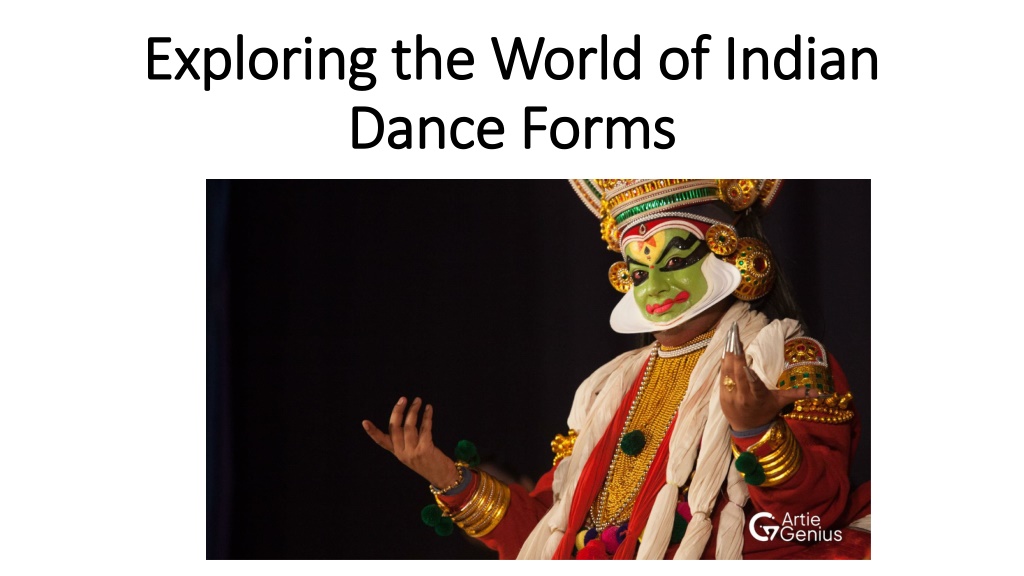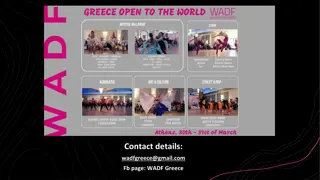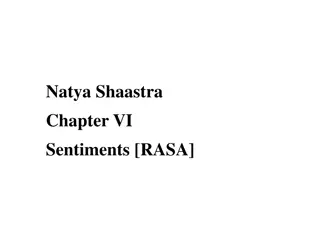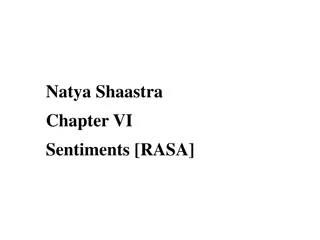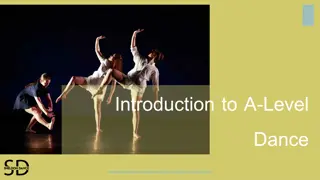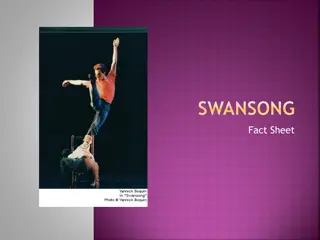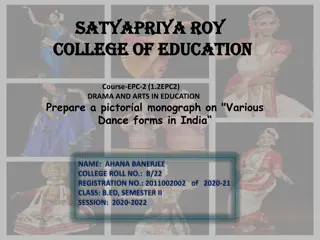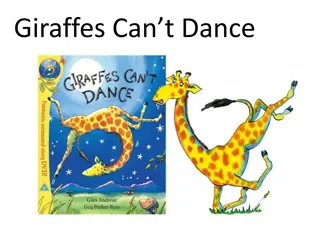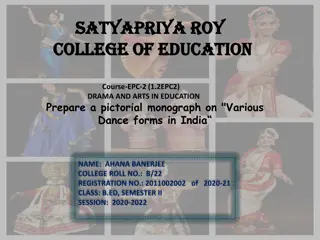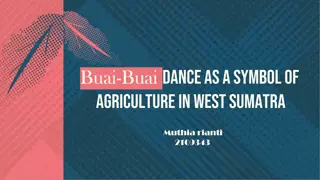Exploring the World of Indian Dance Forms
Discover the beauty and diversity of Indian Classical Dance Forms, from the graceful movements of Bharatanatyam to the storytelling of Kathak. Explore the history, styles, and significance of these ancient art forms.n
Download Presentation

Please find below an Image/Link to download the presentation.
The content on the website is provided AS IS for your information and personal use only. It may not be sold, licensed, or shared on other websites without obtaining consent from the author. Download presentation by click this link. If you encounter any issues during the download, it is possible that the publisher has removed the file from their server.
E N D
Presentation Transcript
Exploring the World of Indian Exploring the World of Indian Dance Dance Forms Forms
Indian dance forms are a vibrant and integral part of the country's cultural heritage, reflecting its rich history, traditions and beliefs. Each dance form is unique, with its own set of movements, gestures, and expressions, making them a captivating and expressive art form. From the graceful movements of Bharatnatyam to the dramatic storytelling of Kathakali, Indian dance forms offer a glimpse into the diverse cultural tapestry of India.
Lets explore the most prominent Indian dance Let s explore the most prominent Indian dance forms forms Bharatnatyam: Bharatnatyam, often referred to as the "Fifth Veda" in Indian philosophy, is one of the oldest classical dance forms of India. It originated in Tamil Nadu and is known for its grace, purity, and sculptural poses. Bharatnatyam is characterized by its precise footwork, intricate hand gestures and elaborate facial expressions. The dance form typically follows a specific sequence of movements, starting with alarippu (a rhythmic piece) and progressing to more complex compositions like varna and pada. Bharatnatyam is not just a form of entertainment but a spiritual and philosophical journey. It embodies the essence of Bharat's Natya Shastra, a treatise on performing arts and is deeply rooted in Hindu mythology and philosophy. Bharatnatyam has evolved over the years, adapting to modern sensibilities while retaining its traditional elements. Today, it is performed on stages around the world, captivating audiences with its beauty and grace.
Manipuri Dance: Manipuri dance originated in the northeastern state of Manipur and is known for its delicate and lyrical movements. It is characterized by its use of storytelling through dance, depicting themes from Hindu mythology and Manipuri folklore. Manipuri dance is often accompanied by traditional Manipuri music and instruments, creating a mesmerizing and spiritual experience for the audience. Kathak: Kathak, originating from the word "Katha," meaning story, is not just a dance form but a means of storytelling. It has evolved over the centuries, blending elements of Persian, Mughal, and indigenous Indian styles. Kathak is known for its intricate footwork, rhythmic complexities, and expressive gestures. The dance form often narrates stories from Hindu mythology and folklore, engaging the audience with its emotive storytelling. Kathak's repertoire includes a wide range of rhythmic patterns, known as tukras and tihais, which are executed with precision and grace. The dance form also incorporates elements of abhinaya, or expression, through facial expressions and hand gestures, making it a visually captivating art form. Kathak has undergone significant transformations over the years, adapting to changing social and cultural landscapes.Today, Kathak is not only performed in traditional settings but also in contemporary contexts, showcasing its versatility and relevance in modern times. Many renowned Kathak dancers have emerged, each contributing to the evolution and preservation of this ancient art form.
Odissi Dance: Odissi is a classical dance form from the eastern state of Odisha, known for its fluid movements and expressive storytelling. It is characterized by its use of sculpturesque poses (bhangas) and graceful gestures (mudras). Odissi dance often depicts themes from Hindu mythology and is performed to classical Odissi music. Kathakali: Kathakali is a classical dance form from Kerala, known for its elaborate costumes, dramatic makeup, and stylized movements. It is often referred to as a "dance drama" as it combines elements of dance, music, and acting. Kathakali performances typically depict stories from Hindu mythology, with dancers portraying various characters using intricate facial expressions and gestures. Kathakali is characterized by its elaborate costumes, which include colorful skirts, headdresses, and facial makeup. The dancers also wear anklets that produce rhythmic sounds as they move, adding to the overall spectacle of the performance. Kathakali requires years of rigorous training to master, as dancers must learn the intricate hand gestures, facial expressions, and body movements that are unique to this art form. This dance form has a long and rich history, dating back to the 17th century. It has evolved over the years, incorporating elements from other dance forms and styles. Today, Kathakali is not just a cultural tradition but also a source of pride for the people of Kerala, who continue to preserve and promote this ancient art form.
Mohiniattam: Mohiniattam is a classical dance form from Kerala, known for its graceful movements and expressive storytelling. It is often referred to as the "dance of the enchantress" due to its lyrical and feminine style. Mohiniattam is characterized by its gentle swaying movements, delicate footwork, and subtle expressions. The performances typically depict stories from Hindu mythology, with dancers portraying various characters through their movements and expressions. The dance form also includes elements of abhinaya, or expression, where dancers convey emotions through facial expressions and hand gestures. Kuchipudi: Kuchipudi is a classical dance form from Andhra Pradesh, known for its dynamic footwork, rhythmic movements, and expressive storytelling. It is characterized by its use of narrative songs (jatis) and dramatic gestures (abhinaya) to convey stories from Hindu mythology and folklore. Kuchipudi is often performed to classical Carnatic music and is known for its energetic and vibrant style. Sattriya Dance: Sattriya dance is a classical dance form from Assam, known for its graceful movements and spiritual themes. It is characterized by its use of storytelling through dance, depicting scenes from the life of Lord Krishna and other Hindu deities. Sattriya dance is often performed as a form of worship in the monasteries (sattras) of Assam.
Chhau: Chhau is a traditional dance form from eastern India, known for its energetic movements and martial arts elements. It is characterized by its use of masks, elaborate costumes, and acrobatic movements. Chhau is often performed during festivals and special occasions, showcasing the rich cultural heritage of the region. Conclusion: Indian dance forms are a testament to the country's rich cultural heritage and artistic traditions. Each dance form is a unique expression of the region's history, beliefs and customs, reflecting the diversity and beauty of India's cultural tapestry. As we explore the world of Indian dance forms, we gain a deeper appreciation for the artistry, skill, and dedication of the dancers who bring these ancient traditions to life. By celebrating and preserving Indian dance forms, we ensure that future generations can continue to be inspired by the beauty and grace of this timeless art form.
